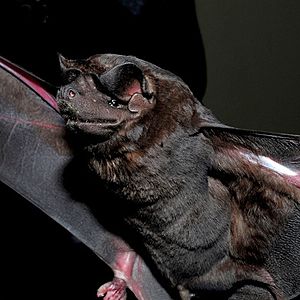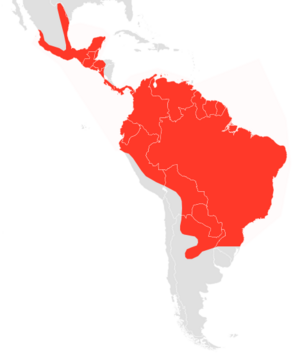Black mastiff bat facts for kids
Quick facts for kids Black mastiff bat |
|
|---|---|
 |
|
| Conservation status | |
| Scientific classification | |
| Genus: |
Molossus
|
| Species: |
rufus
|
 |
|
| Black mastiff bat range | |
| Synonyms | |
|
Molossus ater |
|
The black mastiff bat (Molossus rufus) is a type of bat. You can find it in many parts of northern South America (but not Chile), most of Central America (except Belize), and some areas of southern Mexico.
Contents
About the Black Mastiff Bat
The black mastiff bat was first officially described as a new species in 1805. A French scientist named Étienne Geoffroy Saint-Hilaire gave it its scientific name. The very first bat of this kind that scientists studied was found in Cayenne, French Guiana.
What Does It Look Like?
Black mastiff bats are small but mighty!
- Male bats have forearms that are about 48.5–54.0 mm (1.91–2.13 in) long.
- Female bats have forearms that are a bit shorter, around 47–53 mm (1.9–2.1 in) long.
- The fur on their backs is usually very short, less than 3.5 mm (0.14 in).
- These bats weigh about 27–31 g (0.95–1.09 oz), which is roughly the weight of a few strawberries.
- They have a special set of 26 teeth, which helps them eat their food.
Where Do Black Mastiff Bats Live?
The black mastiff bat lives in many different places. It is found across a large area of Central and South America. You can find these bats in countries like:
- Argentina
- Belize
- Bolivia
- Brazil
- Colombia
- Costa Rica
- Ecuador
- El Salvador
- French Guiana
- Guatemala
- Guyana
- Honduras
- Mexico
- Nicaragua
- Panama
- Paraguay
- Peru
- Trinidad and Tobago
- Uruguay
Their favorite places to live are forests and areas with lots of shrubs. They often use human buildings, like old houses or barns, as safe places to rest during the day.
Protecting Black Mastiff Bats
Good news! As of 2015, the black mastiff bat is considered a least-concern species by the IUCN. This means that scientists believe it is not currently in danger of disappearing. There are a few reasons for this:
- They live in a very wide area.
- There are likely many of them in the world.
- Their numbers are not dropping quickly.
Sometimes, these bats can get a tiny parasitic bug called Hesperoctenes fumarius. But overall, the species is doing well!
See also
 In Spanish: Murciélago mastín negro para niños
In Spanish: Murciélago mastín negro para niños


